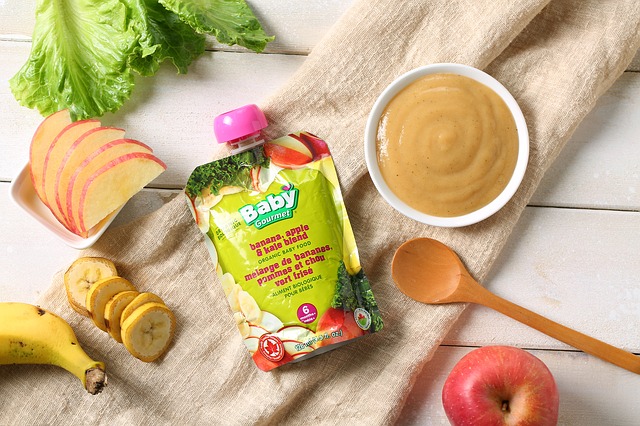The grocery store is a fascinating place. It used to be the baking aisle was two long shelves of flour, baking soda, sugar, chocolates, spices, nuts, baking mixes, shortening and vegetable oil. Which makes me chuckle because that baking grandeur has been reduced to about 1/2 of one side of the aisle while several aisles over, the cereal selection occupies both sides of its aisle, while a few aisles over, water and sports drinks take up both sides of an aisle.
Baby food used to be the same as well, occupying a small amount of real estate on one aisle. Today, however it is is almost the Park Place of aisles, expanded into section upon section of tiny jars of organic pureed foods and, yes, pouches.
There is no question pouches are convenient and when used on occasion, make sense. But pouches are being used for everything from snack to comfort food to sneaking in veggies and all to the detriment of the end user.
Think about it in these terms: newborns and babies nurse or bottle feed, then progress to spoon feeding and then to self feeding. There is a developmental hierarchy that must take place in order for each stage to build on the next. This is the way Mother Nature built us not only so that we wouldn’t eat pureed pears at adult dinner parties, but so we could learn to talk. This progression helps us learn to use the muscles in the mouth and tongue to form words and speak clearly.
So What is the Progression?
We nurse or bottle feed and suck, then progress to spoon feeding which happens around 6 months and lasts for only a few months. This is the transition to chopped up foods, which then leads to self-feeding. The spoon fed foods are going to be predominantly pureed but the ultimate goal is to move into foods with more texture and begin to require chewing.
Learning to eat requires a lot of work and practice, each piece of the puzzle builds on a skill developed before it. This process usually takes place in the 6 months between 12 and 18 months when the mouth begins to gain coordination and strength.
If a pouch or pureed food is being overused during this critical time, children don’t develop fundamental feeding skills and this could lead to loss of foundational speech skills as well. Let’s be honest, one thing babies are really good at is sucking. Pouches only encourage more sucking rather than developing necessary skills for eating and speaking.
What are the Steps from Sucking to Talking?
First, sucking is a very different mechanical process than eating off a spoon for a reason. When sucking, the tongue moves forwards and backwards to move liquids, but at about 6 months, babies have developed the ability to move the tongue from side to side allowing the introduction of more textured foods which require chewing.
Second, when predominantly sucking food during this critical stage, children don’t have a chance to build the skills to enunciate “m,” “p,” and “b” because they have not had the opportunity for the lips to come together to pull food off a spoon. On top of that, the tongue isn’t getting the opportunity to lift up and back as it would in a swallow pattern for more solid foods. This up and back tongue pattern is needed to develop the sounds “t,” “l,” “n,” and “d.” Spending more time sucking and less time moving solid food a this stage limits clear speech and a child’s ability to enunciate as they develop their verbal skills.
Third, there is the sensory experience that is removed from the development process when pouches are used and only pureed food is consumed. It is at this same age that children begin to develop and expand their palette to include different textures. Too much pureed food will encourage picky eating and limits on the sensory experience needed to try new things down the road. In other words, heightened battles at future meal times.
Fourth, pouches are all based on something sweet. This does not expand or challenge the palette in any way and for that reason pouches are not a good trade for vegetables. As humans, we secure out palette before 7 years old and setting children up for sweet preference will not serve them well in adulthood.
Pouches, which first came on the market around 2008, have already risen to 25% of baby food sales today indicating a significant consumption level. Believing that a child is eating kale or broccoli because it is mixed in the pouch is tricking both the child and the adult.
Don’t forget that pouches have calories too, around 45-100 calories each, mostly from sweetened sources impacting both weight and tooth decay. More than one pouch a day could add an extra 200 or more calories to a child’s daily caloric intake.
Speech and sweet: big impact from just a little pouch, so think twice before handing one over!
